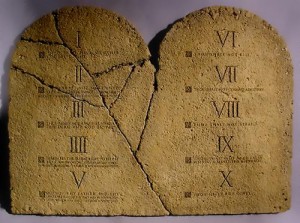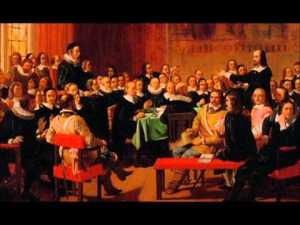
Two Different Definitions of Merit
pp.36-41 of the Merit and Moses paper presented to the OPC Northwest Presbytery.
This booklet has been published now. Please get the booklet.
http://www.amazon.com/Merit-Moses-Critique-Doctrine-Republication/dp/1625646836
Part 2: The Republication Paradigm
The Republication Paradigm: Merit Divorced from Ontology
In the Republication Paradigm, merit is not defined ontologically, but covenantally. This redefinition of merit (which will be explained below in more detail) is central and foundational to the doctrine of republication. Shepherd (along with Daniel Fuller and FV proponents) have formulated a theology that categorically rejects the concept of merit in God’s covenantal arrangements. In so doing, they have appealed to the Biblical principle of the ontological disproportion between man and God. Yet, they have rejected the traditional doctrine of the covenant of works. They have deemed the idea of Adam’s merit to be an inconsistent compromise of the Reformation’s insistence of salvation and eternal life by God’s grace alone. We believe that Kline (among many others) was correct in expressing concern over the categorical rejection of Adamic merit and the merit of Christ. The Bible’s two-Adam covenantal structure demands that we account for the unique theological parallel between the two Adams and their mutual ability to perform perfect, personal obedience. We believe this was done in a careful and theologically balanced way through the traditional distinction between “covenant merit” and “strict merit.” By confusing or failing to account for these two, many have gone as far as to reject the merit of Christ. In Part 1, we observed that Norman Shepherd did eventually reject the necessity of Christ’s imputed active obedience, and thus undermined the doctrine of justification.
Nevertheless, in his reaction to Shepherd’s pendulum swing away from the ideas of “merit” and the “covenant of works,” we believe Kline swung the pendulum too far in the other direction (as was presented in Part 1). Yet, the editors of TLNF have stated their position clearly; they agree with Kline’s conviction that the republication view is necessary, and will better serve the church by guarding against the errors of Shepherd. Instead of seeking to recover what we regard to be the balanced and Biblically faithful view of merit and the covenant of works in our Confession and other creeds of the Reformed church, Kline and many of his followers have found it necessary to reformulate these ideas apart from ontological considerations. In our view, the resulting paradigm has serious repercussions on other important elements in the Reformed system of doctrine.
The Klinean reformulation includes three key elements, which will be considered below, point by point.
1. The conflation of creation and covenant (essentially eliminating the logical distinction between the two).
2. The rejection of the necessity of God’s voluntary condescension to establish the covenant with man.
3. The redefinition of merit and justice along covenantal lines to the exclusion of Ontology.
1. Man is in Covenant with God at the Moment of Creation
The republication view teaches that man was in covenant with God at the very moment of creation. This is an important shift from the traditional viewpoint. Ontological considerations demand that there be at least a logical distinction (rather than a chronological or historical sequence) between God’s creating man and his entering into covenant with him. The republication teaching now erases this confessional distinction (which is based upon the “great disproportion” between the Creator and creature), and thereby turns God’s providential work of establishing the covenant into an aspect of the work of creation. Thus, we may say that the two distinct acts have been conflated or collapsed into essentially one act in this new view. For all intents and purposes, the relationship between God and man is not first that of sovereign Creator over his finite creature, but is from the point of creation a relationship of “God-in-covenant-with-man.” For Professor Kline and those who have followed his lead in the republication position, it is improper to even consider man’s existence apart from covenant. Thus, man’s covenantal status seems to “trump” his creaturely status. Professor Kline makes this clear in Kingdom Prologue.
Man’s creation as image of God meant, as we have seen, that the creating of the world was a covenant-making process. There was no original non-covenantal order of mere nature on which the covenant was superimposed. Covenantal commitments were given by the Creator in the very act of endowing the mancreature with the mantle of the divine likeness. …The situation never existed in which man’s future was contemplated or presented in terms of a static continuation of the original state of blessedness (Kingdom Prologue [2000], p. 92).
A recent book, Sacred Bond,10 written on the popular level concerning Reformed covenant theology, has put the Klinean reformulation in simple terms.
“…God is the one who made the covenant, and he did so at creation. For Adam and Eve to be made in the image of God is for them to be in covenant with God” (Sacred Bond [2012], p. 43).
The obliteration of the distinction between creation and covenant is extremely significant for laying the foundation of a new paradigm of merit—one that is divorced from ontological considerations.
We have already observed that the Creator-creature distinction lies at the center of the doctrines of God, man, and of the covenant in the history of Reformed theology. This distinction is also central to the traditional understanding of merit, as the differences between Adam’s covenant merit and Christ’s strict merit rest on ontological factors. It is apparent that the adherents to the Republication Paradigm have followed Professor Kline in their departure from the tradition in this regard. Professor David VanDrunen shows his agreement with Kline in TLNF.
Meredith Kline (1922-2007) follows his Reformed predecessors closely in affirming the works principle operative in the covenant with Adam and in associating this works principle with the reality of the image of God. He resolves the ambiguity patent in many of his predecessors, however, by refusing to separate the act of creation in the image of God from the establishment of the covenant with Adam. For Kline, the very act of creation in God’s image entails the establishment of the covenant, with its requirement of obedience and its prospect of eschatological reward or punishment. …God’s creating Adam in his image and the establishment of the covenant are aspects of the same act, and thus Adam’s image-derived natural human knowledge that obedience brings eschatological life was at the very same time covenantal knowledge of a special relationship with God (VanDrunen, TLNF, p. 291).
It is debatable whether Kline’s “Reformed predecessors” actually taught this conflation of creation and covenant, and whether it is fair to characterize the tradition as having “ambiguity” on this point. In his review of TLNF, Venema seeks to set the record straight.
VanDrunen’s characterization of this “ambiguity” in historic theology is rather puzzling. There is little evidence that many covenant theologians in the orthodox period simply identified the covenant of works with man’s creation in God’s image and subjection to the moral law of God. Rather than being an ambiguity in Reformed covenant theology, the distinction (without separation) between the creation of man in God’s image and the institution of the prelapsarian covenant of works is nearly the unanimous opinion of the covenant theologians of the sixteenth and seventeenth centuries. VanDrunen’s claim that there is an ambiguity in Reformed covenant theology on this point is belied by the express language of the Westminster Confession of Faith, when it describes the covenant as a “voluntary condescension” on God’s part. Rather than being an ambiguity in the history of Reformed covenant theology, the consensus opinion expressed in the Confession views the covenant of works as a sovereign and voluntary initiative of God (“The Mosaic Covenant.” Mid-America Journal 21 [2010]: 95).
We will address the idea of “voluntary condescension” in the next point. Here, it is important to underscore that the conflation of creation and covenant within the republication position is a departure from the formulations of the Westminster standards. What is clear in the Standards is that God “entered into” the covenant of works with man as the result of his work of providence, rather than from his work of creation. Shorter Catechism, Q&A 12, explicitly identifies the making of the covenant of works with Adam and Eve as a “special act of providence”—not an act that coincides or co-originates with the work of creation (see Shorter Catechism 10). The Republication Paradigm rejects this formulation of the Standards when it teaches that the covenant relationship is an aspect of creation.
2. Voluntary Condescension Is Eliminated
In the above quote, Venema shows that voluntary condescension is clearly affirmed within the mainstream Reformed position when he writes, “Rather than being an ambiguity in the history of Reformed covenant theology, the consensus opinion expressed in the Confession views the covenant of works as a sovereign and voluntary initiative of God.” The Confession’s articulation of the doctrine appears to be the obvious answer to any claims of “ambiguity” in the tradition. Westminster Confession of Faith 7:1 makes the doctrine of voluntary condescension foundational to God’s covenant with man as an expression of how God bridged the gap of the “great disproportion” between God and man. The Confession indicates that this doctrine is integrally connected to man’s hope of heaven. Even sinless man “could never have any fruition of [God] as their blessedness and reward” without voluntary condescension. One may wonder why TLNF is silent on this integral part of covenant theology. We believe this omission is consistent with the previous point (1 above).
Although the authors of TLNF do not explicitly reject WCF 7:1, as Kline did (cf. Part 1, p. 19), it becomes clear that this is the logical and necessary conclusion of Kline’s viewpoint. Lee Irons wrote extensively about this in the article “Redefining Merit” for the Kline festschrift.
It is therefore incorrect to speak of God voluntarily condescending to the creature to make a covenant. For the very fact of creation itself has already constituted man in a covenant relationship with his creator. This formulation of the mutual reciprocity of creation and covenant shows more clearly than ever that the covenant of works is not a matter of grace but simple justice toward the creature made in God’s image (Creator, Redeemer, Consummator [2000], p. 267).
It is evident that WCF 7:1 becomes problematic for the republication position. Even if an explicit rejection of God’s voluntary condescension (such as the one by Irons) is absent in TLNF, an implicit one remains. The republication view’s “erasure” of the historic distinction between the work of creation and the establishment of the covenant necessarily leads to the rejection of the doctrine. Irons has told us the reason in the above quote. Since the republication position entails that creation itself is conflated with the covenant relationship, there is no need (in this system) to bridge an ontological divide between God and man through voluntary condescension. As Irons clearly states, “For the very fact of creation itself has already constituted man in a covenantal relationship with his creator.”
Thus, in the Republication Paradigm, the doctrine of condescension actually gets in the way. As is reflected in the quote from Irons, adherents of the republication view are concerned that the doctrine of voluntary condescension opens the door to Shepherd’s error. How might this happen? Voluntary condescension would seem to allow for the claim that the covenant relationship between God and Adam is founded on love or grace rather than on a works principle (“simple justice”). This paradigm therefore rejects the idea that God’s goodness, benevolence or unmerited favor is foundational for the establishment of the covenant relationship. Such a rejection of voluntary condescension, in our view, is to throw out the proverbial baby with the bath water, and will lead to catastrophic alterations within the system of doctrine. One cannot remove a foundation stone (“voluntary condescension” in WCF 7:1) without a significant shift occurring—one that will inevitably damage the structure (covenant theology) resting upon it.
3. Merit and Justice Are Determined ‘Covenantally’
The previous two points lead to the third and final element of the Republication Paradigm shift. In light of the conflation of creation and covenant and the removal of voluntary condescension, it becomes evident that the historical Reformed concept of merit must be replaced with a new model. Merit must not be defined ontologically. Merit and justice are no longer to be governed by God’s nature (ontology) or considered in light of the Creator-creature distinction. Nor is the distinction between strict and covenant merit a legitimate or relevant one to make. Instead, merit and justice are to be determined “covenantally.” What does this mean in the republication view? Only the terms of a particular covenant may decide what is “just” and “meritorious.” Merit, in this new paradigm, may be defined as follows: one performs a meritorious work when he fulfills the stated stipulation (i. e., condition or requirement) of a given law-covenant.
This might be confusing to some readers because this redefined notion of merit uses the term “covenant merit” in a novel way. This term has been used historically in one way, but is now being used with a different meaning. What are the precise differences between the Klinean version of “covenant merit” and the traditional view?
The traditional paradigm affirms that Adam’s merit was considered to be covenant merit in distinction from strict merit. In other words, Adam’s perfect obedience, as a creature, is being contrasted with Christ’s obedience as the God-man. On the one hand, Adam’s obedience was counted as meritorious on the basis of the covenant which had been established as an expression of God’s voluntary condescension. He had the ability to perform perfect, personal obedience to the law as the ground of his reward. (This stands in contrast to the covenant of grace, which requires faith in Christ as the way of salvation.) However, Adam’s finite works of obedience could never be considered as valuable as the infinite gift of eternal life. On the other hand, Christ’s obedience could be counted as strictly meritorious since it was inherently worthy of receiving such a reward. Thus, the traditional definition of covenant merit is dependent on ontological considerations. In the traditional view, “covenant merit” only possessed meaning as it stood in contrast to “strict merit.” It existed as part of a Biblical and systematic theology that not only took into account the Creator-creature distinction, but viewed it as foundational for its theology. Nevertheless, strict and proper merit did actually exist in the history of redemption. It is hardly an example of theological abstraction or speculation that would detract from a concrete Biblical theology of justice and merit. Instead, “strict merit” serves to uniquely identify the merits of Jesus Christ which were historically accomplished on behalf of his people, in the fulfillment of his active and passive obedience.
Within the new Republication Paradigm, “covenant merit” is used to communicate a different concept than what has been understood by the customary use of the term. The new use of “covenant merit” no longer serves to communicate the importance of the ontological divide between the Creator and creature. In fact, the Klinean-republication version of “covenant merit” is no longer based upon, defined by, or understood in reference to ontology at all. Points 1 and 2 above have laid the groundwork for understanding why the Republication Paradigm has removed all ontological considerations from the definition of merit. The pathway has been cleared for a new paradigm of merit.
In the republication view, merit is defined in terms of God’s revealed will as specified by the terms of the covenant. Simply stated, merit is whatever God says it is. According to the republication position, the nature of the specified condition is ultimately irrelevant for determining its meritorious or non-meritorious character. The condition may be perfection (as in the covenant with Adam), or it may be something less than perfection (as in the Mosaic covenant). A work is meritorious, therefore, simply when God decides to accept it as such through the stated stipulations or conditions of a particular covenantal arrangement. Kline referred to this as “simple justice.”
In keeping with the nature of God’s covenant with Adam as one of simple justice, covenant theology holds that Adam’s obedience in the probation would have been the performing of a meritorious deed by which he earned the covenanted blessings (Kline’s unpublished version of “Covenant Theology Under Attack” at http://upper-register.com/papers/ct_under_attack.html).
If God gives a particular condition in a particular covenant, and that condition is met through obedience, then it is a matter of God’s simple justice that he reward that obedience as meritorious. As Kline says elsewhere, “…God’s covenant Word is definitive of Justice” (God, Heaven and Har Magedon, p. 64). Note what follows. In this redefined view of merit, there is no longer any need or place for the previous distinction made between Adam’s covenant merit in contrast to Christ’s strict merit. In terms of the definition of merit, Adam and Christ can equally earn the rewards of their respective covenants according to the principle of simple justice.
It is also important to note another ramification of this new paradigm. Just as the respective obedience of Adam and Christ would be deemed equally meritorious according to the definition of “simple justice,” so also the works of others, beyond (or between) the two federal heads, may equally be counted as meritorious. The Republication Paradigm allows for only one category or definition of merit (“covenant merit”) which is applied equally to Adam, to Christ, as well as to other figures after the fall (such as Noah, Abraham, and Israel). This explains why meritorious works of obedience are possible for sinners between Adam and Christ in this new paradigm. The redefinition of merit “allows” God to make another meritorious arrangement outside of the ones made with the two Adams. After the fall, in the Mosaic covenant, for example, God may decide to make an arrangement in which he promises temporal-typological blessings on the basis of Israel’s imperfect, sincere, national obedience, instead of the perfect, entire and personal obedience which was required of the two covenant heads (see following diagram).
Simple Justice
Adam———————————–Israel———————————Christ
Perfect Obedience–Imperfect National Obedience–Perfect Obedience
The redefinition of “covenant merit” does not require any ontological considerations. In fact, it does not even require moral perfection on the part of man. Thus, the fact that Israel’s works are those of fallen sinful creatures is completely irrelevant. They are meritorious because God says so. All that matters is that they fulfill God’s covenant Word, which alone defines and determines what constitutes merit and justice in any given covenantal arrangement.





You must be logged in to post a comment.